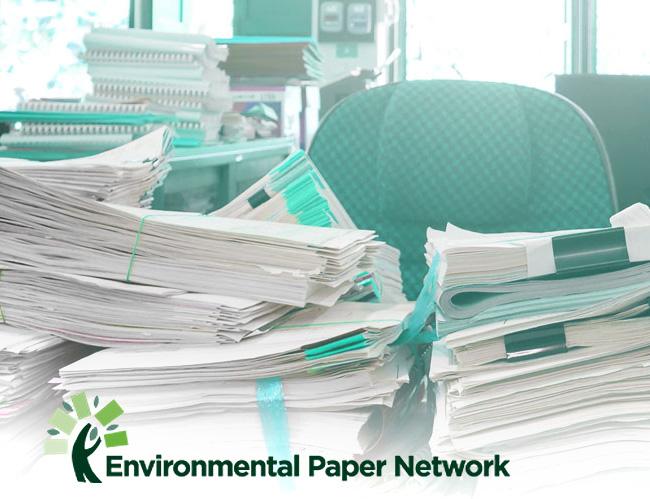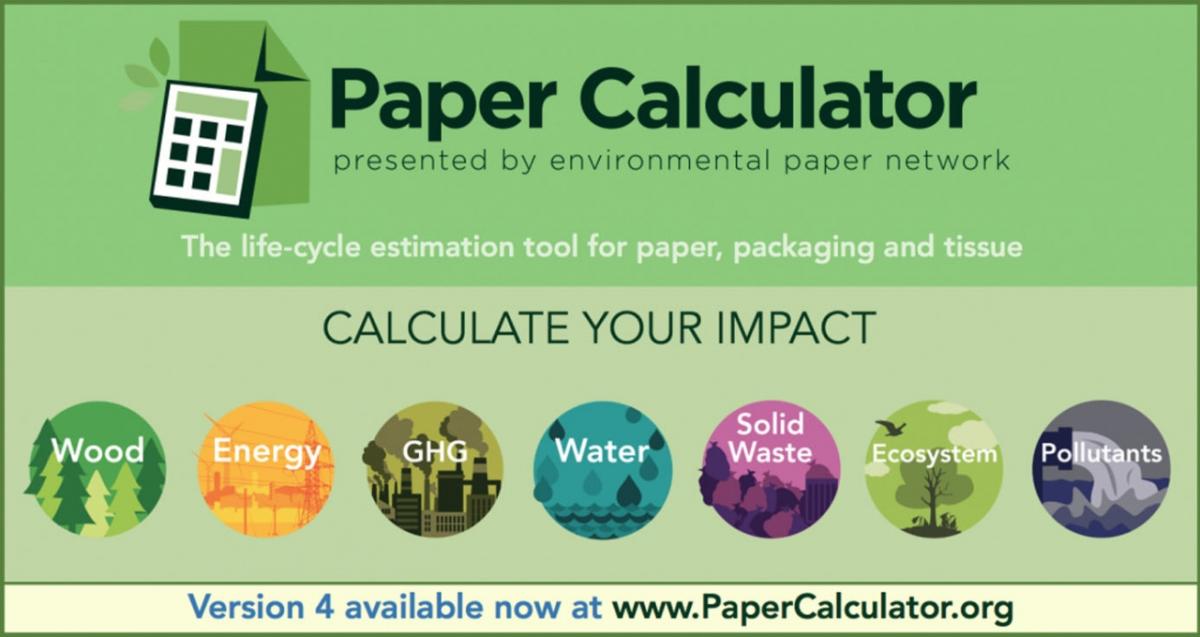How Green Is Your Paper? The Answer Isn’t Black or White
That's where the EPN's Paper Calculator comes in.
By Linda Brown, SCS Global Services
For years, people have debated the question of whether paper derived from wood pulp can truly be environmentally friendly. To answer this question, you must consider the sustainability of the source of the wood or other materials used for fiber production, the amount of fiber, water, energy, and other resources used in production, the amount and fate of pollutants generated during the production process, and the potential recyclability or biodegradability of the end product. In short, the entire product life-cycle.
Such an assessment clearly lies beyond the ability of the average consumer. But fortunately, the latest version of the Environmental Paper Network’s Paper Calculator makes the job much easier for governmental, NGO, institutional and corporate purchasers.
Here’s a short background. The Environmental Paper Network (EPN) is a global coalition of more than 140 non-profit organizations working to advance the sustainable production, consumption, and recycling of pulp and paper. In 2011, EPN took ownership of the Paper Calculator, originally developed by the Environmental Defense Fund (EDF) in cooperation with a private-sector initiative called the Paper Task Force. It was conceived as a tool to bring transparency to the impacts of different paper choices, and to drive industry improvement. EDF’s original analytical tool was built based on information learned from an in-depth peer-reviewed study of paper’s environmental impacts.
Since 2011, EPN has continued to upgrade the Paper Calculator to make it the one of the most widely used tools for making environmentally responsible paper choices. Available free online, the Calculator allows users to enter their custom paper usage data to calculate an estimated life cycle impact report. Users can also compare the impacts of virgin fiber paper to paper products made from recycled fiber and easily compare the environmental impacts of each. Among its many applications, the Paper Calculator helps educate users about paper production’s impacts, and helps organizations set and track sustainability goals. It can be used to create charts and reports supporting environmentally informed paper purchasing decisions, to provide environmental impact statements, and much more.
The latest version of the Paper Calculator (Version 4.0) for North America, released July 12th, is the most comprehensive yet, bringing new depth and transparency to the environmental analysis. Key updates include more current, primary data and integration of regionalized data sets, providing more reliable North American average results, and improved coverage in the areas of climate change, ocean acidification, particulate and acid-rain related emissions, forest ecosystem disturbance, and threatened species – a total of 24 indicators in all. Additionally, the calculator addresses an expanded range of paper grades, and now includes the growing sector of tissue products.
These updates reflect the efforts of EPN and a committee of leading environmental groups such as Canopy, NRDC and Conservatree, as well as representatives from academia and business – facilitated by SCS Global Services, a leading third-party certifier and standards developer – to develop and apply a new international “Product Category Rule” (PCR) for roundwood and pulp and paper products. The PCR was written in accordance with international standards for Environmental Product Declarations and LCA (ISO 14025, ISO 14044), and built around advanced life-cycle assessment (LCA) principles. It specifies the impacts to be assessed and the metrics to be used.
The Paper Calculator incorporates data from 300 pulp and paper mills across the U.S. and Canada, drawing from the RISI Mill Asset Database on forest products as well as additional public and private sources. It now covers 14 different paper grades, including tissue paper, linerboard, uncoated freesheet (copy paper), coated freesheet (high-end catalog), uncoated groundwood (newspaper), coated groundwood (magazine), corrugated container and paperboard.
“The Paper Calculator is a trusted resource for high-profile companies, leading NGOs, educators and others as they consider their paper choices and track progress toward sustainability goals,” said Kim Porter of the Environmental Paper Network. “This new version provides even more reliability, features and up-to-date information. We’re grateful to the many experts who played a part in updating the calculator to this new level of knowledge and transparency. “
Larger Strategy. EPN views the Paper Calculator v4.0 as part of a larger strategy to transform the forest products industry, as described in its “Global Paper Vision.” This vision includes reducing consumption and ensuring fair access, maximizing recycling, ensuring social responsibility, promoting responsible forestry practices, protecting climate, engaging in cleaner production methods, and promoting transparency and integrity. A select group of companies, NGOs and other organizations designated by EPN as “Power Users,” including Bloomberg, Mohawk, Lexmark, and Numi Tea, to name a few, help offset the costs of operating the Paper Calculator to maintain it as a free resource for thousands of users each month.
In addition to growing usage of the calculator, EPN cites many additional signs that transformation is taking place, including “the legal protection of millions of acres of endangered forests; significant increases in the number of paper-related certifications and forest acres certified by the Forest Stewardship Council (FSC); hundreds of large companies developing environmental paper policies; the rapidly growing availability of genuine environmental papers to purchasers; decreases in U.S. and European over-consumption; and increased demand for, and use of, recovered fiber.”
Remaining Challenges. Still, EPN has its work cut out. Fourteen percent of all globally harvested wood is used to make paper, according to The World Counts, a consumer-oriented data crunching non-profit. This translates worldwide to the production of about 400 million metric tons of paper and cardboard, an amount which is increasing steadily, based on paper industry statistics. Citing data compiled by the United Nations FAO, the EPN’s latest State of the Paper Industry Report (2018) noted that, as of 2014, the average person in North America – the world’s highest paper consuming region – used about 474 pounds of paper per year. And even as paper consumption in North America levels off, consumption elsewhere is on the rise, especially in Asia.
Moreover, despite overall paper recycling rates now above 65% in the US, more than 22 million tons of paper end up in US landfills. There is still room to improve – Canada and Europe are already recycling at rates of 70% or higher, and Japan and Australia have achieved recycling rates of 80 and 85% – but the sheer volume of paper produced and used means that what remains is still overwhelming. Given that product packaging now accounts for more than half of total global paper use, packaging waste represents a particular challenge.
Ultimately, the Paper Calculator reminds users that every paper choice has consequences far beyond the landfill itself. The latest update is timely and important.
Linda Brown is Senior Vice President and co-founder of SCS Global Services. To learn more about the latest Paper Calculator updates, the PCR and the LCA study behind it, contact Keith Killpack, Manager of LCA Services at SCS Global Services at kkillpack@scsglobalservices.com, or call +1.510.452.8047. To learn more about EPN, contact Kim Porter at kim@environmentalpaper.org, or call +1.828.645.5340.
If you enjoyed this article, be sure to SUBSCRIBE to SCS Topics to be alerted whenever we publish new articles





